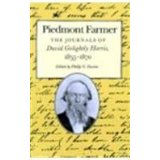Importance of
Bivingsville's Industries in Earlier Times
It
is not generally known how important the Bivingsville industrial
complex was to the surrounding area during
earlier times. The fact that the people of Spartanburg
County depended heavily on Bivingsville
is told in a diary and journal kept before, during, and
after the Civil War. The journal was kept by David
Golightly Harris who lived near the present communities
of Pauline and Golightly. He and his wife, Emily, kept
an account of the day by day happenings with their
family, their slaves, their farm and neighbors from
1885-1870. Retired Wofford Professor, Philip
N. Racine, has edited and compiled this interesting book
titled Piedmont Farmer, the Journals of David
Golightly Harris ; 1855-1870. The book was
published by The University of Tennessee Press and is
available from Amazon.com.

Probably
90
% of the book is about the weather and his crops. Even
this part of the book opens a different view of an
Upstate farm. He kept silk worms and produced silk. He
grew indigo, peanuts, tobacco, had an ice house and
raised sheep for wool. These are not what we usually
associate with a Spartanburg County farm. However, the
final 10% of the book is fascinating and should be of
great interest to anyone wanting to know about life in
Spartanburg County at the time of the Civil War.
The
reader
will be struck by the prominent part that Bivingsville plays in
the life of the Harris family. He went to the "village",
as he called Spartanburg, fairly often. However, his
real interest seemed to be at Bivingsville, or "the
Factory" as he called it, where he went sometimes once
or twice a week. He took his wheat there to be made into
flour. Sometimes, he took his corn there to be ground
into meal. He took wool to the wool mill at Bivingsville to be made
into yarn - not cloth. He sold some of his cotton to the
cotton mill there. During the Civil War he went to the
"Factory "often to buy quantities of yarn, not cloth,
which he resold. Yarn from the mill was so scarce that
it was used as "currency" in buying things in the area.
Finally, he sometimes came to "the Factory" to meet with
Mr. Bomar and borrow money from him. The Mill actually
served somewhat as a bank for Mr. Harris. It seems that
if Mr. Harris was anywhere in the remote vicinity of
“the Factory” on any kind of business he would find a
reason to stop there.
The
Harris
farm was close to where present day, Highway 56, crosses
Fairforest Creek. The distance from his house to “the
Factory” was about eight miles. This was no quick and
easy trip in a horse and wagon but often he made the
trip weekly. Sometimes, the roads were just too bad for
him to make the trip. It is likely that the round trip
to "the Factory" and conducting his business took all
day. Nowadays, we could make the trip by car in about
the time it took him to catch his horse and harness it
up to the wagon.
He
does not say the exact route he traveled to get from his
farm to Bivingsville.
It seems that the most likely route was for him to go to
the vicinity of the Cedar Springs Baptist Church and
then strike the Old Georgia Road that led to Bivingsville. The Old Georgia Road dates
back to the
Revolutionary War and was an old road even in
David Harris’ time. He frequently took his family to the
Cedar Springs church on Sunday.
Elsewhere
on
this
website,
the importance of Bivingsville
to the Confederacy is discussed. They produced iron
weapons and a variety of other things including wooden
shoe soles. We see from the Journal that the yarn
produced during the war was vital to the civilian
population living in the area.
Bivingsville/Glendale has
a long and varied history of service to the Spartanburg
and Upstate area. There is no reason to believe that
this will not continue in the future. One step to
showing that this is true is the establishment of Wofford’s Goodall
Environmental Center.

This web site has been started as a
public service to share the story of Glendale. See more
information about Mary and her Glendale connection at Mary McKinney Teaster.

